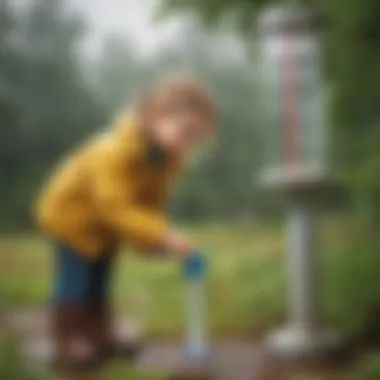Captivating Activities for Exploring Weather and Seasons: LabLittles Guide


Science Fun Facts
Weather and seasons are fascinating topics that play a crucial role in our daily lives. Understanding them can help us predict changes in the environment, plan outdoor activities, and appreciate the beauty of nature. Did you know that the Earth is tilted on its axis, causing different parts of the planet to receive varying amounts of sunlight throughout the year? This tilt is what creates the seasons we experience.
Discover the Wonders of Science
Exploring weather and seasons with Lab Littles opens up a world of scientific concepts in a fun and interactive way. Through educational videos and animations, children can learn about how weather patterns develop, why seasons change, and how different climates impact ecosystems around the globe. Interactive learning tools on LabLittles help kids grasp these concepts easily and apply them to real-life scenarios.
Science Quiz Time
Engaging in science quizzes on Lab Littles is a fantastic way for children to test their knowledge on weather and seasons. With multiple-choice questions, brain teasers, and puzzles, young learners can challenge themselves while having fun. By blending education with gamification, these quizzes make learning about weather and seasons an exciting adventure for kids of all ages.
Science Experiment Showcase
The science experiment showcase on Lab Littles offers a hands-on approach to exploring weather and seasons. Children can engage in fun and educational experiments that demonstrate the principles behind atmospheric conditions and seasonal changes. With step-by-step instructions, a materials list, and safety tips, kids can safely conduct experiments at home while uncovering the wonders of weather and seasons.
Understanding Weather Patterns
Understanding weather patterns is essential for grasping the intricate workings of the environment. In this article, we delve into the fundamental principles governing weather phenomena, offering insights into the mechanisms behind weather changes. By exploring weather patterns, children aged 6-12 can cultivate a deeper appreciation for the natural world and the forces that shape our daily lives. This section aims to provide a comprehensive overview of meteorological concepts, cloud formations, and precipitation cycles, paving the way for a more profound understanding of seasonal variations and weather-related events.
Basic Concepts of Weather
Meteorology serves as the cornerstone of weather study, laying the groundwork for comprehending atmospheric processes. Through an introduction to meteorology, young learners can grasp the basic principles guiding weather forecasting and analysis. Gaining familiarity with concepts such as temperature and humidity equips children with the tools to interpret and predict weather changes effectively. The exploration of these fundamental aspects of weather not only enhances scientific understanding but also nurtures a curiosity for the natural world.


Introduction to meteorology
Introducing children to meteorology offers them a glimpse into the scientific study of the atmosphere. Through meteorology, youngsters can uncover the secrets of weather prediction and analysis, unlocking a realm of knowledge that shapes everyday decision-making. Understanding meteorological principles provides a solid foundation for exploring weather patterns and phenomena, cultivating a sense of wonder and inquiry among young minds.
Explaining temperature and humidity
The concepts of temperature and humidity play a pivotal role in shaping weather conditions. By explaining the significance of temperature in weather systems and the influence of humidity on air moisture content, children can grasp the interconnectedness of these variables. Nurturing an understanding of temperature and humidity empowers young learners to interpret weather patterns and make informed observations about their surroundings.
Exploration of Cloud Types
Cloud formations offer a visual representation of atmospheric dynamics, reflecting the ever-changing nature of weather systems. By exploring different cloud types, children can appreciate the diverse forms and characteristics of clouds, linking them to specific weather conditions. Understanding cloud types enhances observational skills and fosters an appreciation for the beauty and complexity of the sky.
Cirrus, cumulus, and stratus clouds
Diving into the realms of cirrus, cumulus, and stratus clouds unveils a world of cloud diversity. Each cloud type possesses unique characteristics, from the wispy tendrils of cirrus clouds to the fluffy expanses of cumulus clouds. By examining these distinctive features, children can discern the role each cloud plays in signaling impending weather changes, honing their predictive abilities and observational acumen.
Formation and characteristics
The formation and characteristics of clouds offer valuable insights into atmospheric processes. By understanding how clouds form and evolve, young learners can connect cloud appearances to specific weather events. Delving into the intricacies of cloud dynamics deepens children's comprehension of atmospheric phenomena, setting the stage for further exploration and discovery.
Learning About Precipitation
Precipitation events such as rain, snow, sleet, and hail constitute vital components of the water cycle and weather systems. By examining precipitation processes, children can unravel the mechanisms driving these natural phenomena, from condensation to precipitation. The study of precipitation not only elucidates the water cycle but also underscores the interconnectedness of weather elements in shaping our environment.
Rain, snow, sleet, and hail


Investigating the intricacies of rain, snow, sleet, and hail sheds light on the diverse forms of precipitation. Each type of precipitation carries distinct characteristics and formation mechanisms, offering young learners a glimpse into the manifold ways water manifests in the atmosphere. Exploring the properties of precipitation expands children's understanding of weather dynamics and enhances their observational skills.
Water cycle explanation
The water cycle serves as a fundamental process driving weather patterns and environmental cycles. By elucidating the intricacies of the water cycle, children can trace the journey of water molecules through evaporation, condensation, and precipitation. Understanding the water cycle not only illuminates the mechanisms behind precipitation events but also underscores the dynamic interplay between land, air, and water on Earth.
Seasonal Adventures
Importance of Seasonal Adventures in the Context of Exploring Weather and Seasons
Seasonal Adventures play a pivotal role in enhancing children's understanding of weather patterns and seasonal changes. In this article, Seasonal Adventures serve as a cornerstone for hands-on learning experiences that connect theoretical knowledge to real-world phenomena. By immersing children in activities related to different seasons, Lab Littles aims to instill a deep appreciation for nature's cycles and foster curiosity about the world around them. Understanding the impact of seasonal changes not only cultivates environmental awareness but also stimulates scientific inquiry, critical thinking, and observational skills. Through Seasonal Adventures, children can develop a holistic perspective on weather and seasons, paving the way for a lifelong interest in meteorology and Earth sciences.
Investigating Seasonal Changes
Differentiating between Seasons
Differentiating between seasons is a fundamental aspect of seasonal exploration. By discerning the distinct characteristics of each season such as temperature, foliage, and daylight hours, children can grasp the cyclical nature of the Earth's climate. This knowledge enables them to identify patterns, make predictions, and understand the reasons behind seasonal transformations. The ability to differentiate between seasons not only enriches children's cognitive development but also encourages them to engage in comparative analyses and critical reflection. Through activities that highlight the differences between seasons, children can cultivate a sense of environmental stewardship and adaptability, preparing them to face complex ecological challenges in the future.
Effects of Earth's Tilt
Understanding the effects of Earth's tilt is crucial for comprehending the seasonal variations in different regions. The tilt of the Earth's axis is responsible for the changing angle of sunlight that leads to seasonal changes. By exploring the effects of Earth's tilt through educational activities, children can appreciate how this astronomical phenomenon influences climate patterns and biodiversity globally. Recognizing the impact of Earth's tilt on seasonal transitions fosters a deeper understanding of terrestrial ecosystems and promotes cross-disciplinary learning encompassing geography, astronomy, and environmental science. Engaging with the effects of Earth's tilt empowers children to connect celestial mechanics to earthly phenomena, offering a multifaceted perspective on the interconnectedness of natural systems.
Engaging with Spring
Flower Dissection Activity


The Flower Dissection Activity introduces children to the intricate structures of flowering plants, enhancing their botanical knowledge and observational skills. By dissecting flowers, children can examine reproductive parts such as petals, stamens, and pistils, gaining insights into pollination and plant reproduction. This hands-on exploration not only promotes scientific inquiry but also cultivates an appreciation for floral diversity and ecological interdependence. The Flower Dissection Activity encourages children to explore the intersection of biology and botany, fostering curiosity about the natural world and the mechanisms that drive plant growth and development.
Growth of Plants and Flowers
Exploring the growth of plants and flowers provides children with a firsthand opportunity to witness the life cycle of flora and understand the environmental factors that influence their development. By nurturing plants from seeds to maturity, children can learn about photosynthesis, soil nutrients, and seasonal influences on plant growth. This experiential learning journey not only connects children to the rhythm of nature but also instills a sense of responsibility towards caring for living organisms. Observing the growth of plants and flowers empowers children to appreciate the interconnectedness of all living things and fosters an eco-conscious mindset that values sustainable practices and environmental conservation.
Interactive Learning Tools
In this segment of the article, we delve into the significance of Interactive Learning Tools within the context of Lab Littles and its endeavors to educate and engage young learners in weather and seasonal exploration. These tools play a pivotal role in enhancing the educational experience by providing a hands-on approach to learning. By incorporating interactive elements, LabLittles ensures that children aged 6-12 can actively participate in the exploration of weather phenomena and seasonal changes, fostering a deeper understanding and appreciation for science.
When discussing Virtual Weather Simulations within the Interactive Learning Tools section, the focus is on the educational value of online platforms for weather forecasting. These platforms offer a dynamic way to engage children in real-time weather data, predictions, and analysis, providing a practical application of theoretical concepts. By immersing themselves in virtual weather simulations, kids can observe weather patterns, understand forecasting methods, and develop critical thinking skills related to meteorology.
- Online platforms for weather forecasting: Online platforms offer an interactive interface that allows children to explore various weather parameters and predictions. By accessing real-time data and simulations, young learners can grasp the complexities of meteorology in a visually appealing and accessible manner. The benefit of these platforms lies in their ability to make abstract concepts tangible and relatable, fostering a deeper interest in weather science among Lab Littles' audience.
- Building a weather station at home: Another aspect of Virtual Weather Simulations involves building a weather station at home, enabling children to create their own weather monitoring system. By constructing a simple station using everyday materials, kids can collect data on temperature, humidity, and precipitation, gaining practical experience in weather observation. This hands-on approach not only reinforces learning but also encourages independent exploration and scientific inquiry among young enthusiasts.
Moving on to Seasonal Craft Activities, these creative projects add a fun and artistic dimension to Lab Littles' weather and seasonal exploration. By engaging in hands-on crafting experiences, children can express their creativity while learning about seasonal changes and weather phenomena in a visually engaging way.
When exploring Creating weather mobiles, the focus is on creating artistic representations of weather elements that can be displayed and admired. These mobiles not only serve as decorative pieces but also provide a visual aid for understanding weather patterns and symbols. By constructing weather mobiles, children can learn about different weather conditions and how they are depicted in meteorology, enhancing their artistic and scientific skills concurrently.
- Creating weather mobiles: Crafting weather mobiles involves assembling various weather symbols and elements into a hanging display that moves with air currents. This activity encourages children to identify and conceptualize different weather patterns, fostering creativity and imagination. The benefit of creating weather mobiles lies in its multisensory approach to learning, combining visual and tactile experiences to deepen understanding and retention of weather concepts.
- Seasonal diorama projects: Similarly, Seasonal diorama projects offer a hands-on way to explore seasonal changes and showcase creative interpretations of weather phenomena. By constructing dioramas that depict different seasons, children can visually represent the effects of weather and Earth's tilt on nature. These projects not only encourage artistic expression but also provide a platform for discussing the cyclic nature of seasons and environmental influences on plant and animal life.
Safety Measures and Exploratory Tips
In the realm of child exploration of weather and seasons, emphasis on safety measures and exploratory tips is paramount. As children engage in hands-on activities to understand the elements, ensuring their well-being becomes a crucial component of the learning process. By integrating safety measures and exploratory tips into the activities, Lab Littles aims to provide a secure environment for children to explore and learn effectively. Through proactive considerations and careful planning, the risks associated with weather-related experiments are minimized, allowing children to delve into the exciting world of meteorology with confidence.
Safety Precautions in Weather Activities
When it comes to weather-related activities, implementing safety precautions is vital to safeguard children from potential hazards. One prominent aspect that requires attention is sun safety guidelines. Addressing the importance of protecting children from excessive sun exposure during outdoor explorations is essential. By promoting awareness about sun safety measures such as wearing sunscreen, hats, and staying hydrated, Lab Littles ensures that children can partake in activities without compromising their health. The focus on sun safety guidelines underscores LabLittles' commitment to prioritizing children's well-being while fostering a love for science and nature. Proper attire for different seasons also plays a significant role in mitigating risks during weather-centric experiments. Educating children on dressing appropriately based on seasonal variations is instrumental in maintaining their comfort and safety. By discussing suitable clothing choices for varying weather conditions, Lab Littles equips children with the knowledge to stay secure and engaged in their learning pursuits. The emphasis on proper attire not only enhances the practicality of weather activities but also instills a sense of preparedness and responsibility in young learners.
Encouraging Curiosity in Weather Exploration
Encouraging curiosity in weather exploration is a cornerstone of Lab Littles' educational initiatives. By fostering a sense of wonder and inquisitiveness in children, LabLittles cultivates a lasting interest in meteorology and seasonal phenomena. A key aspect of nurturing this curiosity is through activities such as keeping a weather journal. By recording observations, noting trends, and reflecting on meteorological patterns, children develop a deeper understanding of weather dynamics. The practice of maintaining a weather journal not only hones observational skills but also encourages critical thinking and analytical abilities, enriching the learning experience. Field trips to observe weather phenomena offer a hands-on approach to exploring natural elements in real-world settings. By immersing children in outdoor environments where weather events unfold, Lab Littles provides a unique opportunity for experiential learning. Engaging in field trips enables children to witness meteorological occurrences firsthand, fostering a profound appreciation for the intricacies of weather systems. Through guided excursions and interactive experiences, LabLittles sparks a sense of discovery and curiosity in young learners, inspiring them to explore the wonders of weather with enthusiasm and insight.







